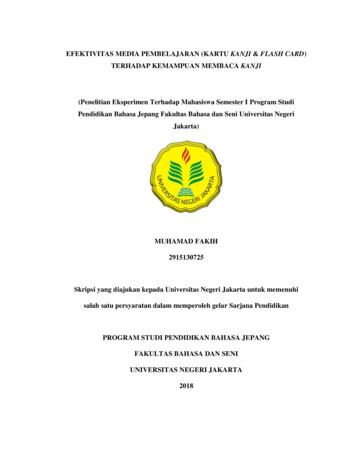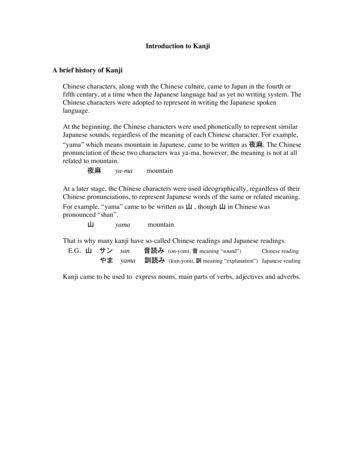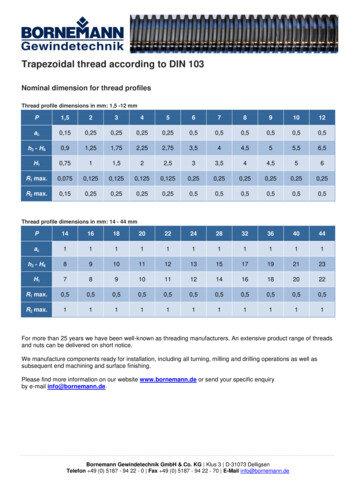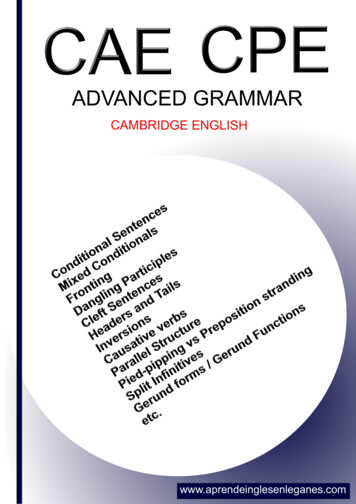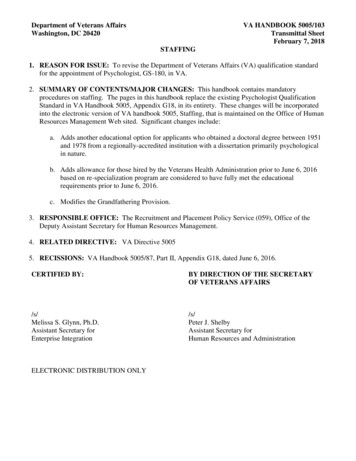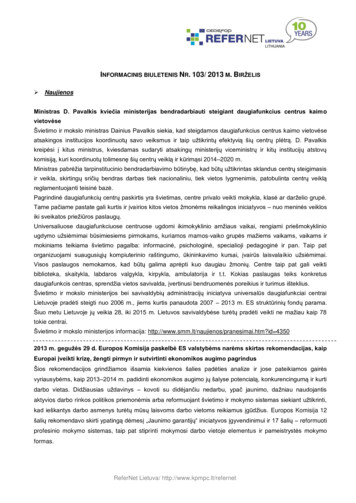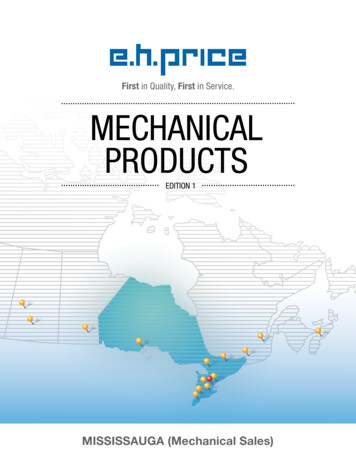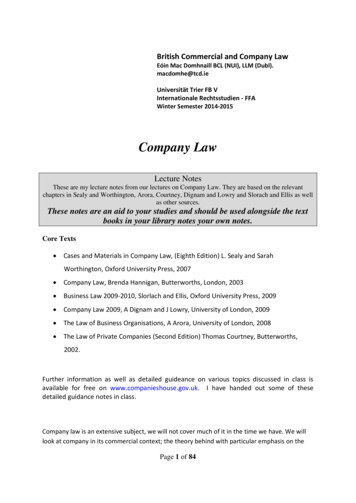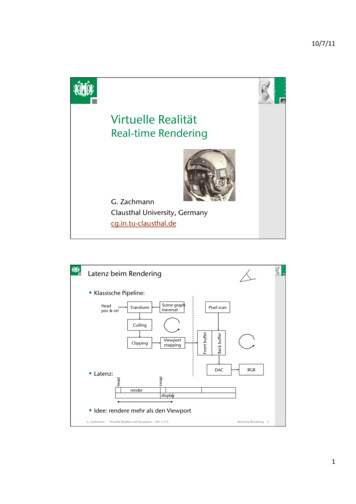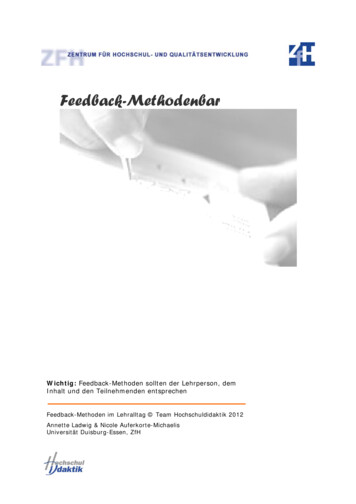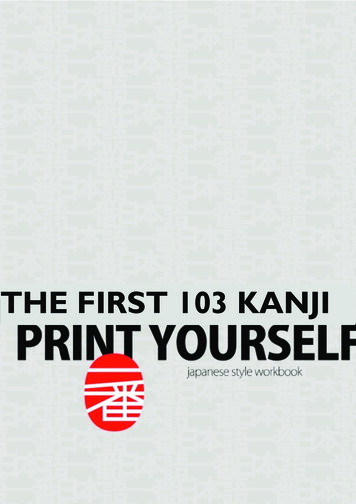
Transcription
THE FIRST 103 KANJI
About this bookThis book helps beginners of the Japanese language memorizing andwriting the first 103 kanji characters required for the JapaneseLanguage Proficiency Test N5.Each kanji is represented on one page featuring: Its meaningThe onyomi and kunyomi readingsVocabulary that includes this kanjiThe number of strokes and the stroke order with a link to theNIHONGO ICHIBAN website to video showing the stroke order The radicals (components) the kanji consists of A hint to help memorizing the kanji A grid to exercise writingYou can print each page on your own printer and repeat the writingexercises as often as you like.
CopyrightThis book is a service to the community of Japan fans.THERE IS NO COPYRIGHT!Please feel free to share it with your friends and other students ofJapanese.About usNIHON ICHIBAN is a social business to promote Japanese cultureand lifestyle in the world. With our free websites we serve acommunity of more than 92,000 fans of Japan in more than 150countries.The NIHON ICHIBAN SHOP is the leading online shop for authenticJapanese craft, design and food products. Please visit our shop firstwhen you need something from Japan.NIHONGO ICHIBAN:NIHON ICHIBAN:JAPAN BLOG DIRECTORY:NIHON ICHIBAN rom-japan.com
The Japanese writing systemThe Japanese written language consists of a combination of three types of characters. Toa lesser extend it nowadays also uses some Latin alphabet for abbreviations andnumbers.1) Kanji (漢字)Kanji originally came from China to Japan. The term “kanji” literally means “Hancharacters” or “Chinese characters” and it is identical to the characters in China todescribe their writing.Kanji are mainly used to describe names and nouns. When used in verbs and adjectivesthey mostly are written in combination with hiragana. Most sentences include kanji as wellas hiragana.Japanese dictionaries list around 10,000 kanji. The Japanese government limited the kanjiused in official publications to the 1945 touyou kanji with about 4000 readings. TheJapanese Language Proficiency Test (JLPT) is based on these 1945 touyou kanji.A Japanese with average education knows around 3000 kanji and it is estimated thataround 4000 kanji are used in Japanese literature.2) Hiragana (平仮名)Hiragana is a phonetic alphabet that was developed in the ninth century to simplify writing.It nowadays is mainly used for native Japanese words. Hiragana are derived from morecomplex kanji and each hiragana represents a syllable. A total of 46 hiragana are used incontemporary Japanese writing.List of the 46 hiragana and their 25 diagritics (with or )AIUEOあ (a)い (i)う (u)え (e)お (o)か (ka)き (ki)く(ku)け (ke)こ (ko)が (ga)ぎ (gi)ぐ (gu)げ (ge)ご (go)さ (sa)し (shi)す (su)せ (se)そ (so)ざ (za)じ (ji)ず (zu)ぜ (ze)ぞ (zo)た (ta)ち (chi)つ (tsu)て (te)と (to)だ (da)ぢ (ji)づ (zu)で (de)ど (do)な (na)に (ni)ぬ (nu)ね (ne)の (no)
AIUEOは (ha)ひ (hi)ふ (fu)へ (he)ほ (ho)ば (ba)び (bi)ぶ (bu)ベ (be)ぼ (bo)ぱ (pa)ぴ (pi)ぷ (pu)ぺ (pe)ぽ (po)ま (ma)み (mi)む (mu)め (me)も (mo)や (ya)ゆ (yu)ら (ra)り (ri)る (ru)わ (wa)よ (yo)れ (re)ろ (ro)を (o/wo)ん (n)The combination of some of these hiragana is used to express a few additional soundsused in Japanese. The first character is written in normal size whereas the secondcharacter is written a little bit smaller. These combinations are called digraphs.List of 21 hiragana digraphs and their 15 diagriticsYAYUYOきゃ (kya)きゅ (kyu)きょ (kyo)ぎゃ (gya)ぎゅ (gyu)ぎょ (gyo)しゃ (sha)しゅ (shu)しょ (sho)じゃ (ja)じゅ (ju)じょ (jo)ちゃ (cha)ちゅ (chu)ちょ (cho)ぢゃ (ja)ぢゅ (ju)ぢょ (jo)にゃ (nya)にゅ (nyu)にょ (nyo)ひゃ (hya)ひゅ (hyu)ひょ (hyo)びゃ (bya)びゅ (byu)びょ (byo)ぴゃ (pya)ぴゅ (pyu)ぴょ (pyo)みゃ (mya)みゅ (myu)みょ (myo)りゃ (rya)りゅ (ryu)りょ (ryo)3) Katakana (片仮名)Katakana also is a phonetic alphabet covering the same syllable as hiragana and ittherefore also has 46 different characters. It is mainly used for foreign loanwords andsometimes to replace kanji or hiragana for emphasis. Katakana were developed in theninth century and are also derived from more complex kanji.
List of the 46 basic katakana and their 25 diagritics (with or )AIUEOア (a)イ (i)ウ (u)エ (e)オ (o)カ (ka)キ (ki)ク (ku)ケ (ke)コ (ko)ガ (ga)ギ (gi)グ (gu)ゲ (ge)ゴ (go)サ (sa)シ (shi)ス (su)セ (se)ソ (so)ザ (za)ジ (ji)ズ (zu)ゼ (ze)ゾ (zo)タ (ta)チ (chi)ツ (tsu)テ (te)ト (to)ダ (da)ヂ (ji)ヅ (zu)デ (de)ド (do)ナ (na)ニ (ni)ヌ (nu)ネ (ne)ノ (no)ハ (ha)ヒ (hi)フ (fu)ヘ (he)ホ (ho)バ (ba)ビ (bi)ブ (bu)ベ (be)ボ (bo)パ (pa)ピ (pi)プ (pu)ペ pe)ポ(po)マ (ma)ミ (mi)ム (mu)メ (me)モ (mo)ヤ (ya)ユ (yu)ラ (ra)リ (ri)ル (ru)ワ (wa)ヨ (yo)レ (re)ロ (ro)ヲ (o/wo)ン (n)As with hiragana there also are combinations to express the other sounds required for theJapanese language.List of 21 katakana digraphs and their 15 diagriticsYAYUYOキャ (kya)キュ (kyu)キョ (kyo)ギャ (gya)ギュ (gyu)ギョ (gyo)シャ (sha)シュ (shu)ショ (sho)ジャ (ja)ジュ (ju)ジョ (jo)チャ (cha)チュ (chu)チョ (cho)ぢゃ (ja)ヂュ (ju)ヂョ (jo)ニャ (nya)ニュ (nyu)ニョ (nyo)
YAYUYOヒャ (hya)ヒュ (hyu)ヒョ (hyo)ビャ (bya)ビュ (byu)ビョ (byo)ピャ (pya)ピュ (pyu)ピョ (pyo)ミャ (mya)ミュ (myu)ミョ (myo)リャ (rya)リュ (ryu)リョ (ryo)These 46 katakana and their variations are sufficient to express all sounds used forJapanese words. In order to get closer to the pronunciation of foreign words, a list of notso common extended katakana is used.List of extended katakanaAIUイィ (yi)EOイェ (ye)ウァ (wa)ウィ (wi)ウゥ (wu)ウェ (we)ウォ (wo)ヴァ (va)ヴィ (vi)ヴ (vu)ヴェ (ve)ヴォ (vo)ヴィェ (vye)キェ (kye)ギェ (gye)クァ (kwa)クィ(kwi)クェ (kwe)クォ (kwo)グァ (gwa)グィ (gwi)グェ (gwe)グォ (gwo)シェ (she)ジェ (je)スィ (si)ズィ (zi)チェ (che)ツァ (tsa)ツィ (tsi)ツェ (tse)ティ (ti)テゥ (tu)ディ (di)デゥ (du)ニェ (nye)ヒェ (hye)ビェ (bye)ツォ (tso)
AIUEOピェ (pye)ファ (fa)フィ (fi)フェ (fe)フォ (fo)フィェ (fye)ホゥ (hu)ミェ (mye)リェ (rye)ラ (la)リ (li)ル (lu)レ (le)ロ (lo)4) Writing a Japanese textIt is possible to write everything in hiragana or katakana since both scripts cover the entityof sounds of the Japanese language, although this is not very practical due to the highnumber of words having the same pronunciation but different meanings.All characters are written one by one and in the same size. There are no spaces betweendifferent words, which feels a little bit unusual for most foreigners. It takes time to get usedto this and easily distinguish different words.It is important to write the strokes in the correct order and directions to give the charactersthe right shape. The reason why becomes obvious when practicing with a brush pen1 ,which is very much recommended for beginners.Japanese writing is made in two directions. Horizontal writing (yokogaki) is from the left tothe right as in western style. Traditional writing (tategaki) is vertical starting from the righttop and ending at the left bottom. A book printed in tategaki opens from what Westernerswould call the back, while a book printed in yokogaki opens from what traditionally inJapan would have been considered the back.21A brush pen is a pen with a brush instead of a brush instead of the nib. You can get them in someJapanese shops or via mail order.2Wikipedia, Japanese writing system
Meaning:Onyomi:Kunyomi:Vocabulary:OneIchi / Itsu [いち/いつ]Hito [ひと]一口 - ひとくち - hitokuchi One biteTo check the strokes order click on the link orsearch 4E00 on Nihongo Ichiban1 stroke 一 is just one strokeNIHON ICHIBAN is the largest online shop forauthentic Japanese craft, designs and food.It has a large selection of traditional andcontemporary products of high quality – all madein Japan!www.anything-from-japan.com
Meaning:Onyomi:Kunyomi:Vocabulary:TwoNi [に]Futa [ふた]二人 - ふたり - futari - TwopersonsTo check the strokes order click on the link orsearch 4E8C on Nihongo Ichiban2 strokes 二 is made of two strokes 一 一 二1 1 2NIHON ICHIBAN is the largest online shop forauthentic Japanese craft, designs and food.It has a large selection of traditional andcontemporary products of high quality – all madein Japan!www.anything-from-japan.com
Meaning:Onyomi:Kunyomi:Vocabulary:ThreeSan [さん]Mitsu / Mi- [みつ/みっ]3日 - みっか - mikka - The 3rdTo check the strokes order click on the link orsearch 4E09 on Nihongo Ichiban3 strokes 三 is the result of 一 二1 2 3NIHON ICHIBAN is the largest online shop forauthentic Japanese craft, designs and food.It has a large selection of traditional andcontemporary products of high quality – all madein Japan!www.anything-from-japan.com
Meaning:Onyomi:Kunyomi:Vocabulary:FourShi [し]Yo / Yu / Yon [よ/ゆ/よん]四季 - しき - shiki - The 4seasonsTo check the strokes order click on the link orsearch 56DB on Nihongo Ichiban5 strokes There are four sides to a squareNIHON ICHIBAN is the largest online shop forauthentic Japanese craft, designs and food.It has a large selection of traditional andcontemporary products of high quality – all madein Japan!www.anything-from-japan.com
Meaning:Onyomi:Kunyomi:Vocabulary:FiveGo [ご]Itsu [いつ]五つ - いつつ - itsutsu - Five(ordinal number)To check the strokes order click on the link orsearch 4E94 on Nihongo Ichiban4 strokes It looks like the number 5NIHON ICHIBAN is the largest online shop forauthentic Japanese craft, designs and food.It has a large selection of traditional andcontemporary products of high quality – all madein Japan!www.anything-from-japan.com
Meaning:Onyomi:Kunyomi:Vocabulary:SixRoku [ろく]Mu/Mut/Mui [む/むっ/むい]六つ - むっつ - muttsu - Six(ordinal number)To check the strokes order click on the link orsearch 516D on Nihongo Ichiban4 strokes 6 can be written VI if you turn themaround you get 六NIHON ICHIBAN is the largest online shop forauthentic Japanese craft, designs and food.It has a large selection of traditional andcontemporary products of high quality – all madein Japan!www.anything-from-japan.com
Meaning:Onyomi:Kunyomi:Vocabulary:SevenShichi [しち]Nana/Nano [なな/なの]七月 – しちがつ – shichigatsu- JulyTo check the strokes order click on the link orsearch 4E03 on Nihongo Ichiban2 strokes It is a 7 invertedNIHON ICHIBAN is the largest online shop forauthentic Japanese craft, designs and food.It has a large selection of traditional andcontemporary products of high quality – all madein Japan!www.anything-from-japan.com
Meaning:Onyomi:Kunyomi:Vocabulary:EightHachi [はち]Yat/Ya/You [やっ/や/よう]八つ - やっつ - Yattsu – Eight(ordinal number)To check the strokes order click on the link orsearch 516B on Nihongo Ichiban2 strokes When following the simple shapeof the 8 you get 八NIHON ICHIBAN is the largest online shop forauthentic Japanese craft, designs and food.It has a large selection of traditional andcontemporary products of high quality – all madein Japan!www.anything-from-japan.com
Meaning:Onyomi:Kunyomi:Vocabulary:NineKyuu/Ku [きゅう/く]Kokono [ここの]九日 - ここのか - Kokonoka The 9thCode NIHONGO ICHIBAN: 4E5DTo check the strokes order click on the link orsearch 4E5D on Nihongo Ichiban2 strokes You can see the shape of a 9with a little imaginationNIHON ICHIBAN is the largest online shop forauthentic Japanese craft, designs and food.It has a large selection of traditional andcontemporary products of high quality – all madein Japan!www.anything-from-japan.com
Meaning:Onyomi:Kunyomi:Vocabulary:10thTenJuu/Ji [じゅう/じ]Too [とお]十日 - とおか - Tooka – TheTo check the strokes order click on the link orsearch 5341 on Nihongo Ichiban2 strokes 10 can be written XNIHON ICHIBAN is the largest online shop forauthentic Japanese craft, designs and food.It has a large selection of traditional andcontemporary products of high quality – all madein Japan!www.anything-from-japan.com
Meaning:Onyomi:Kunyomi:Vocabulary:HundredHyaku [ひゃく]/百貨店 - ひゃっかてん Hyakkaten - A mallTo check the strokes order click on the link orsearch 767E on Nihongo Ichiban 100 - I006 strokesNIHON ICHIBAN is the largest online shop forauthentic Japanese craft, designs and food.It has a large selection of traditional andcontemporary products of high quality – all madein Japan!www.anything-from-japan.com
en [せん]Chi [ち]二千円 - にせんえん - Two thousand YenTo check the strokes order click on the link orsearch 5343 on Nihongo Ichiban3 strokes Thousand starts with the letter TNIHON ICHIBAN is the largest online shop forauthentic Japanese craft, designs and food.It has a large selection of traditional andcontemporary products of high quality – all madein Japan!www.anything-from-japan.com
Meaning:Onyomi:Kunyomi:Vocabulary:Ten thousandMan/Ban [まん/ばん]/万引き - まんびき - manbiki –ShopliftingTo check the strokes order click on the link orsearch 4E07 on Nihongo Ichiban3 strokes It looks like a capital T and a h combined likein Thousand and the capital T also stands for TenNIHON ICHIBAN is the largest online shop forauthentic Japanese craft, designs and food.It has a large selection of traditional andcontemporary products of high quality – all madein Japan!www.anything-from-japan.com
Meaning:Onyomi:Kunyomi:Vocabulary:WaterSui [すい]Mizu [みず]水道 - すいどう - suidou Water pipeTo check the strokes order click on the link orsearch 6C34 on Nihongo Ichiban4 strokes It can represent the current of waterNIHON ICHIBAN is the largest online shop forauthentic Japanese craft, designs and food.It has a large selection of traditional andcontemporary products of high quality – all madein Japan!www.anything-from-japan.com
Meaning:Onyomi:Kunyomi:Vocabulary:FireKa [か]Hi [ひ]火山 - かざん - kazan –VolcanoTo check the strokes order click on the link orsearch 706B on Nihongo Ichiban4 strokes It looks like a camp fire with flames flyingaround.NIHON ICHIBAN is the largest online shop forauthentic Japanese craft, designs and food.It has a large selection of traditional andcontemporary products of high quality – all madein Japan!www.anything-from-japan.com
Meaning:Onyomi:Kunyomi:Vocabulary:Tree, woodBoku/Moku [ぼく/もく]Ki/Ko [き/こ]木曜日 - もくようび mokuyoubi – ThursdayTo check the strokes order click on the link orsearch 6728 on Nihongo Ichiban4 strokes It is easy to remember since it looks like a tree!NIHON ICHIBAN is the largest online shop forauthentic Japanese craft, designs and food.It has a large selection of traditional andcontemporary products of high quality – all madein Jap
in Japan! www.anything-from-japan.com Meaning: Six Onyomi: Roku [ろく] Kunyomi: Mu/Mut/Mui [む/むっ/むい] Vocabulary: 六つ - むっつ - muttsu - Six (ordinal number) To check the strokes order click on the link or search 516D on Nihongo Ichiban 6 can be written VI if you turn them 4 strokes around you get 六. NIHON ICHIBAN is the largest online shop for authentic Japanese craft .
